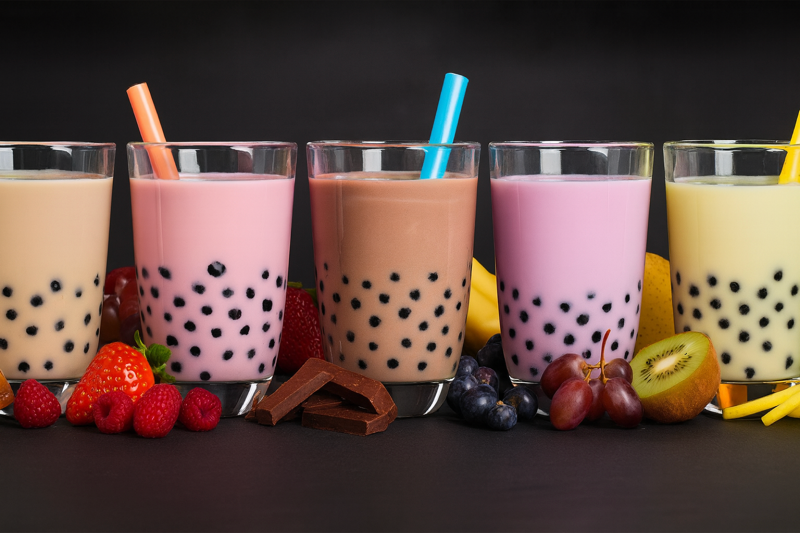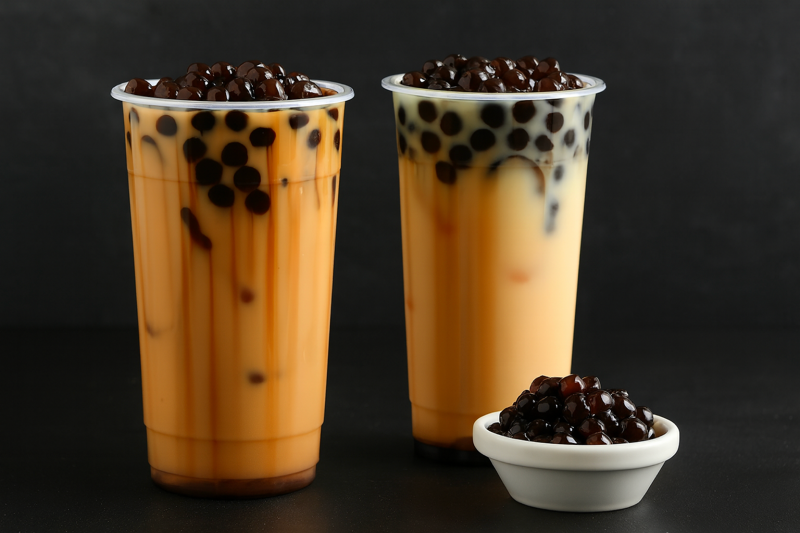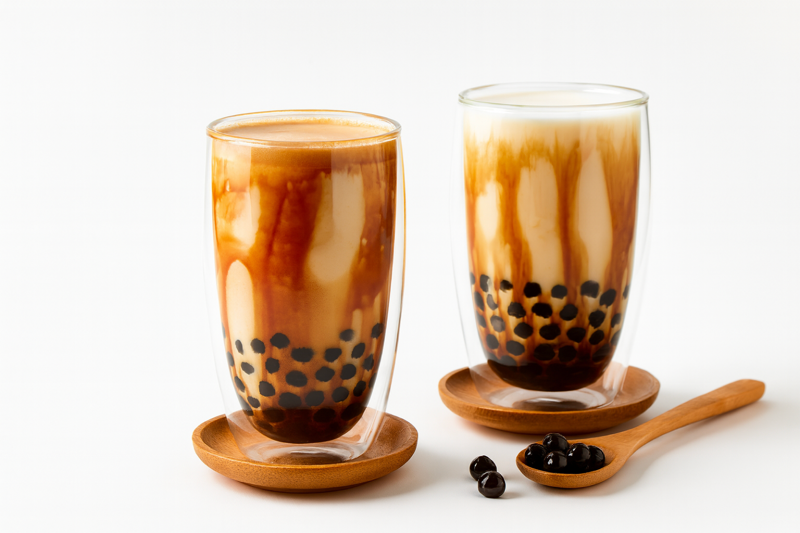Bubble Tea (Boba Tea)
Sweet, creamy, and fun — the modern classic born in Taiwan.
- Category: Flavored tea beverage (usually black tea, green tea, or oolong base with milk and tapioca pearls).
- Origin: Taiwan — created in the 1980s, now a global sensation.
- Harvest: Varies by tea base (black, green, oolong). Tapioca pearls are made from cassava root.
- Grade: Classic Milk Tea with Tapioca Pearls; Fruit Tea with Pearls or Jelly; Specialty Variants (matcha, taro, Thai tea, brown sugar, etc.)



Tasting Profile
Brewing Guide
- Tea-to-water ratioVaries by recipe — usually ~5 g tea leaves per 200 ml water, blended with milk/syrup.
- Water temperature85–95 °C (185–203 °F) for black tea; 80–85 °C (176–185 °F) for green/oolong bases.
- Steeping time3–5 minutes for black tea; 2–3 minutes for green/oolong.
- InfusionsTypically single-use; base tea is brewed once and blended into the drink.
Background & Story
Bubble Tea, often called Boba Tea or Pearl Milk Tea, is one of Taiwan’s most iconic modern creations. Invented in the 1980s, it blends traditional tea with milk, sugar, and chewy tapioca pearls, creating a drink that is both playful and indulgent. Today, bubble tea has evolved into a global craze, available in countless variations that reflect both Taiwanese heritage and international tastes.
The origin of bubble tea is often credited to tea shops in Taichung and Tainan, where creative shop owners experimented by adding tapioca pearls, made from cassava starch, to sweetened milk tea. The chewy texture of the pearls added a fun, interactive element that quickly caught the attention of young people. Some stories attribute the drink’s name to the “bubbles” formed when the tea is vigorously shaken with milk and sugar, while others point to the tapioca pearls themselves. Regardless of its exact beginning, bubble tea became a sensation in Taiwan almost overnight.
The base of bubble tea is usually black tea, green tea, or oolong, brewed strong to balance the sweetness of milk and sugar. Tapioca pearls are boiled until soft and chewy, often sweetened with brown sugar syrup for a rich caramel flavor. Over time, variations emerged, including fruit-based teas, slushies, matcha blends, taro milk tea, and even cheese-foam toppings. The drink is typically served in tall cups with oversized straws, designed to draw up the pearls with each sip.
By the 1990s and early 2000s, bubble tea spread across Asia, becoming especially popular in Hong Kong, China, Japan, and Southeast Asia. Soon after, it made its way to the United States, Europe, and beyond, where it gained a devoted following. Today, bubble tea represents more than just a beverage — it’s a cultural phenomenon, a symbol of youth culture, and a versatile canvas for creative flavor combinations that continue to evolve worldwide.
Benefits
- Provides antioxidants from the tea base (black, green, or oolong)
- Delivers an energy boost from natural caffeine in tea
- Customizable with fruit, matcha, or milk alternatives to suit preferences
- Tapioca pearls offer a fun, satisfying texture that enhances enjoyment
- Acts as a social and cultural experience, bringing people together worldwide
Serving Suggestions
Pairings
- Fried snacks like Taiwanese popcorn chicken or spring rolls
- Light pastries such as egg tarts or sponge cakes
- Savory street foods like scallion pancakes or dumplings
- Fresh fruit bowls, especially mango or strawberries
- Sweet desserts like mochi, custard pudding, or cheesecake
Teaware
- Cocktail shaker (for mixing tea, milk, and sugar to create the “bubble” froth)
- Large bubble tea straw (wide enough for tapioca pearls)
- Tall glass or plastic cup (classic serving vessel for bubble tea)
Nutrition Facts
Nutrition Facts
Serving Size: 1 cup Bubble Tea with tapioca (16 oz / 473 ml)
| Nutrient | Amount per Serving | % Daily Value* |
|---|---|---|
| Calories | 200–250 | 10–12% |
| Total Fat | 3–5 g | 4–6% |
| Saturated Fat | 1–3 g | 5–15% |
| Sodium | 100–150 mg | 4–6% |
| Total Carbohydrates | 40–55 g | 14–18% |
| Sugars | 25–35 g | — |
| Dietary Fiber | <1 g | <2% |
| Protein | 2–4 g | 4–6% |
| Vitamin C | 0–2 mg | 0–3% |
| Calcium | 60–100 mg | 5–8% |
| Potassium | 80–120 mg | 2–3% |
| Magnesium | 5–8 mg | 1–2% |
| Caffeine (from tea) | 30–50 mg | — |
| L-theanine (from tea) | 5–10 mg | — |
**Percent Daily Values are based on a 2,000 calorie diet.
† Values vary significantly depending on tea base, type of milk, sugar level, and toppings. Functional compounds like caffeine and L-theanine are present but not given %DV.